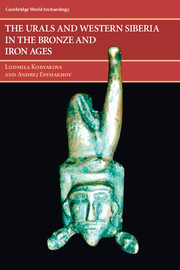Book contents
- Frontmatter
- Contents
- List of Plates, Figures, and Tables
- Foreword, by Philip L. Kohl
- Preface
- Introduction
- PART ONE THE BRONZE AGE: THE RISE OF ECONOMIC AND CULTURAL COMPLEXITY
- 1 The Development of Bronze Metallurgy
- 2 The Achievements and Collisions of the Early and Middle Bronze Age
- 3 Stabilization, Colonization, and Expansion in the Late Bronze Age
- 4 On the Eve of a New Epoch: Final Bronze Age
- PART TWO THE IRON AGE – FORMING EURASIAN INTERACTIONS
- Notes
- References
- Index
2 - The Achievements and Collisions of the Early and Middle Bronze Age
from PART ONE - THE BRONZE AGE: THE RISE OF ECONOMIC AND CULTURAL COMPLEXITY
Published online by Cambridge University Press: 03 February 2010
- Frontmatter
- Contents
- List of Plates, Figures, and Tables
- Foreword, by Philip L. Kohl
- Preface
- Introduction
- PART ONE THE BRONZE AGE: THE RISE OF ECONOMIC AND CULTURAL COMPLEXITY
- 1 The Development of Bronze Metallurgy
- 2 The Achievements and Collisions of the Early and Middle Bronze Age
- 3 Stabilization, Colonization, and Expansion in the Late Bronze Age
- 4 On the Eve of a New Epoch: Final Bronze Age
- PART TWO THE IRON AGE – FORMING EURASIAN INTERACTIONS
- Notes
- References
- Index
Summary
In this chapter, we will emphasize the emergence and development of a productive economy in north-central Eurasia. The Early and Middle Bronze Age is represented by several cultural core traditions, reflecting the eastward spread of western complexes connected with the Yamnaya, Catacombnaya, Abashevo, and Early Srubnaya cultures.
The dynamics of interaction between populations of different landscape zones can be seen even at the beginning of the Bronze Age. The primary impulses emanated from the southern regions, where their inhabitants received and mastered new forms of economy and technology earlier than in the north. The steppe population played the role of transmitter of new ideas, which become a source of cultural transformation for those in the northern territories. The main distinction between the southern and northern cultural zones is that in the steppe area development was not continuous, and an important role was played by migrations. This was in opposition to the northern zone, which was defined by a gradual evolution without any fundamental replacement of population.
However, the role of the forest-steppe and south taiga peoples was not passive. First, southern innovations filtered into traditional cultures that rejected some of these innovations but retained others. Second, the history of the Abashevo and Seima-Turbino groups comprise evidence for the advantages arising out of long-distance migrations, even into a different landscape zone.
This chapter will illuminate the asymmetry in the cultural and economic development between the steppe, forest-steppe, and forest zones, which was characteristic for the beginning of the Bronze Age.
- Type
- Chapter
- Information
- The Urals and Western Siberia in the Bronze and Iron Ages , pp. 45 - 110Publisher: Cambridge University PressPrint publication year: 2007



